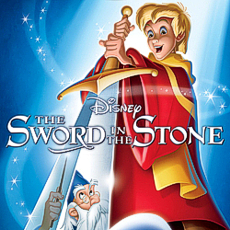Weinstein Company/Film Roman/Lotto Animation (2007), Classic Media/Genius (February 5, 2008), 1 disc, 73 mins plus supplements, 16:9 ratio, Dolby Digital 5.1, Not Rated, Retail: $19.95
Storyboard:
An Indian warrior, cast out from his tribe years earlier, finds himself in a land of dinosaurs battling the legacy of his past deeds.
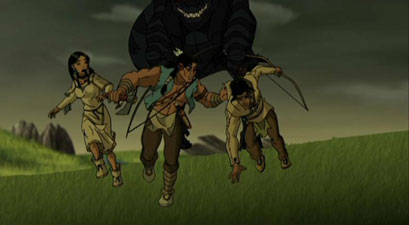
The Sweatbox Review:
It would appear that direct-to-video movies are the last bastion of animated features in North America. With hand-drawn theatrical animated films mostly abandoned in recent years, and Disney still working towards starting to release traditionally-done features again, we old-time cartoon buffs must content ourselves with what is on television or on sale online or at a local store. For those perusing the video section either in cyberspace or down the street these days, it certainly helps to like comic book heroes. In the past couple of years, DC and Marvel have started direct-to-video programs, and Hellboy has also made a decent showing. This is a great trend, which has produced a few pretty good movies to balance out the inevitable mediocre ones. But the last place I expected this trend to go towards was in the direction of Gold Key Comics!

Sure, I well remember that company, owned by Western Publishing, which produced a huge diversity of funny animal, adventure, science fiction, and various adventure comic book concepts from 1962 until the 1970s. Previously, Western partnered with Dell to do its comics before taking over their own publishing and distribution, and after the 1970s the Gold Key label was largely dropped in favor of the Whitman brand as their distribution model changed. In-between, however, they had a handful of original characters that challenged such stalwarts as Batman and Spider-Man for an eight-year old’s allowance every month. The titles Magnus, Robot Fighter 4000AD and Doctor Solar, Man Of The Atom have recently had hardcover reprint collection put out by Dark Horse Comics. However, the longest-lasting original character at Gold Key was actually Turok, Son Of Stone, who began his life when Western was still putting comics together for Dell, appearing in Dell’s Four Color #596 in 1954. After another issue of Four Color, Turok: Son Of stone continued publication in its own title for 130 issues (many of the last ones being reprints), finally ending its Dell/Gold Key/Whitman run in 1982.

It was one cool-looking series, particularly as it followed the Gold Key model of using painted covers decades before they became more common at DC or Marvel. Even without those covers, though, just paging through an issue was enough to impress a young mind, as Turok had one of the neatest set-ups ever in comics. A pre-Columbian American Indian and his young companion (sometimes referred to as his brother) Andar lived in a Lost Valley of dinosaurs, which they referred to as “honkers.” Original writer Gaylord DuBois had a very interesting premise to work with, but the most prolific Turok writer was likely Paul S. Newman, who wrote an amazing amount of comics for Gold Key. In retrospect, I can hardly believe that I read, at most, a single issue of Turok when it was being published. I guess I was always more of a DC guy. I also managed to avoid reading the re-imagined version of the character that debuted with great success from Valiant Comics in the 1990. I also am not much of a gamer, so I have never played the best-selling Turok video game. And yet, for some reason, I was very excited to hear of a direct-to-video movie coming out. Part of the reason is that I always found the concept appealing; but it also signals that the direct-to-video field is growing, and many things are therefore possible.
So this brings us to Turok, Son Of Stone, a new feature supervised by Tad Stones, formerly a producer or director of television series based on Disney’s Aladdin and Hercules, as well as the Hellboy animated films. Assisting him were famous Warner Bros. Television directors Dan Riba and Curt Geda, plus (sorry dude) some guy named Frank Squillace (okay, Squillace worked on Jackie Chan Adventures and Godzilla: The Series). The screenplay writer was Tony Bedard, who had previously scripted Turok comic books, though not the original run. The movie brings Turok back to his roots, nowhere near the latter-day re-imaginings that saw him fighting cybernetically enhanced “bionosaurs” in another dimension. Though this is obviously a fantasy film, the producers and directors did strive for some authenticity, so they hired Valerie Red-Horse as a consultant on aboriginal issues. Thus, Turok’s tribe is roughly based on one that existed in history, though— as far as is known— that tribe never really encountered dinosaurs!

Turok, his brother Nashoba, and female friend Catori are out and about one day when they encounter a group of warriors from another tribe. With their lives threatened, Turok manages to not only save himself and his friends, but he brutally kills all of the attackers. Still in an enraged bloodlust, Turok even accidentally hurts his friend Nashoba, dealing him a near-mortal wound. Turok naturally feels horrible, but the judgment of his tribe’s leaders is harsh, and Turok is expelled from the tribe. He lives alone for the next sixteen years, until he is found by his nephew Andar. Turok finds out that Nashoba managed to recover all those years ago, and he is now chief of the tribe. This boy, Andar, is the son of Nashoba and Catori. The tribe that once attacked Turok and his companions is threatening Turok’s old tribe. Turok, still bitter over being cast out, declines to help, leading to the bloody slaughter of most of his people. It’s never explained why, but the other tribe has firearms, giving them an unfair advantage. (There are also horses present, so these Indians are obviously post-Columbian.)
When Turok changes his mind, it is too late. He does find that Catori has survived, however, and he follows the trail left by the attacking tribe’s leader Chichak, who has kidnapped her. He and Andar follow him right into a mysterious Lost Land, where they very quickly encounter all manner of fantastic beasts, which we know today as dinosaurs. They also find themselves in conflict with a group of monstrous cave people, who later ally themselves with Chichak— who oddly has managed to establish a rapport with the savage, dim-witted creatures. Fortunately, Turok also finds allies, as there is a tribe similar to his own living in the Lost Land. Turok may have resisted rejoining his brothers back home, but in this new world he has to become a part of a people once again if they are all to survive.
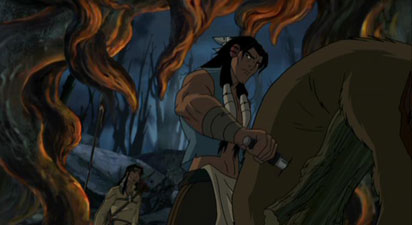
While the overall story is intriguing, and I still love the concept of Turok, the feature’s main problem is that the character himself is not all that likeable or relatable. Through most of the movie, Turok is bitter and angry, and although he does take steps towards becoming part of a new family, his personality changes little during the course of the film. We really never get to know him, and he refuses to interact much with anyone that he isn’t fighting with. Without an endearing protagonist, the rest of the movie falls a little flat, despite some intense action. Or maybe I should use the term “violence,” as things do get pretty graphic. Severed limbs and spurting blood are used to strong effect, making this a movie for older kids and adults only. I’m not sure if this will work at all well commercially, as the producers of the film have severely limited their target audience.
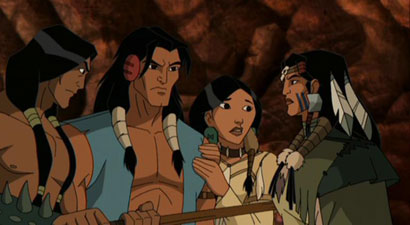
One thing I appreciated is that it was decided that Turok largely eschew the usual hokey pseudo-mysticism often included in animated tales of American Indians. I’m all for seeing the spiritual side of their lives portrayed, but in this film you will thankfully not see any talking trees, shaman-given superpowers, or animal transformations. It is implied that Turok has special abilities, and there are a couple of small supernatural occurrences, but otherwise the story stays grounded.
With direct-to-video features, there are always yahoos who complain that the animation is “terrible” because it doesn’t look like a classic Disney film. The animation here is just fine. In fact, given budget limitations, it’s fairly good. Characters are well drawn, and even if there is the expected lack of total fluidity to the animation, there is some strong attitude seen in how the characters move. The action carries the story forward even as the main character is stuck in his own perpetual funk. Film Roman is not especially known for this type of production, but they and Lotto Animation of Korea carry off this action film reasonably well. With a more likeable protagonist, I could have liked this film a great deal. Instead, it is merely a good idea with a non-involving script and decent animation.

Is This Thing Loaded?
The animated main menu is a nice touch, giving this DTV title a bit of polish. The disc also boasts an Audio Commentary with producer Evan Bailey, supervising director Tad Stones, and the three directors. They give a good look at what how they envisioned the film and the time limitations they faced, as well as the choices made regarding story and depicted violence.
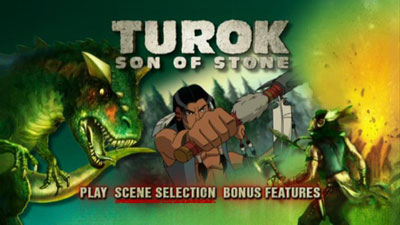
It is a decent commentary, but the feature I enjoyed most was the featurette Total Turok (22:19). This is just the type of bonus I like to see for comic book adaptations, going over the history of the property in question as well as the production of the film itself. After all these years, I finally know something of the origins of Turok, and it is fun to see some of those great painted comic book covers. Contributors to the discussion include the producers and writers of the film, plus Valiant Comics’ Bob Layton and comic book and animation historian Mark Evanier, as well as consultant Valerie Red-Horse and composer James Venable.

Case Study:
Standard keepcase, with reflective identical slip-sleeve. The back cover wisely includes a warning advising parents that this is not a movie for children, and a sticker on the slip-sleeve does the same.
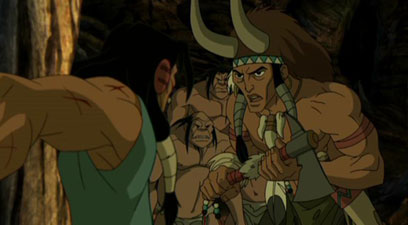
Ink And Paint:
Digital production once again yields a pristine transfer to DVD. Compression work is admirably devoid of any artifacts. Even fog effects look great, and the picture never has trouble keeping up with all the action. The 16:9 anamorphic transfer is as good as it gets on standard DVD, showing off all the wonderful detail given to the props and costumes.

Scratch Tracks:
We are treated to a full 5.1 sound field, and the sound designer went all-out to provide the best experience possible. There is good depth to the audio, and frequent use of the surrounds. At no time during the film do you forget that you’re getting the full package of 5.1 Dolby Digital.
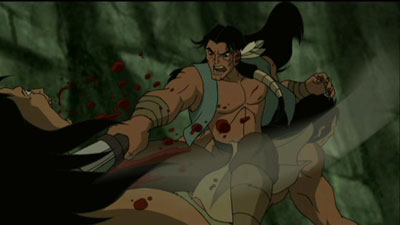
Final Cut:
I never thought I’d see the day when we got a Turok: Son Of Stone feature, and now that it’s here I feel relieved that it wasn’t horrible, but still mildly disappointed that I didn’t like Turok (the character) more. It seems like they were so intent on making this a mature film, they left out some of the fun. A movie’s hero need not be a morose jerk in order to come off as “adult,” yet their Turok fails to allow any viewer identification. The result is that the viewer only watches the movie, rather than getting drawn into it. The film is technically done well, however, and the technical specs on the disc are solid. A good commentary and even better featurette make this a worthwhile package. I’d actually like to see Turok explored further in another film, where he might be allowed to grow into a hero that we want to spend more time with. I also would love to see a Magnus or Doctor Solar film, if Turok’s graphic excesses don’t prevent it from doing well commercially.
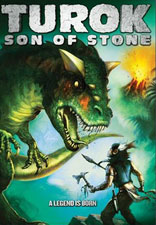 | ||
 |








